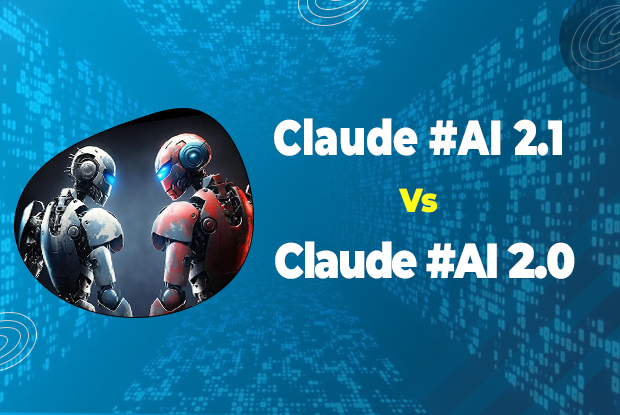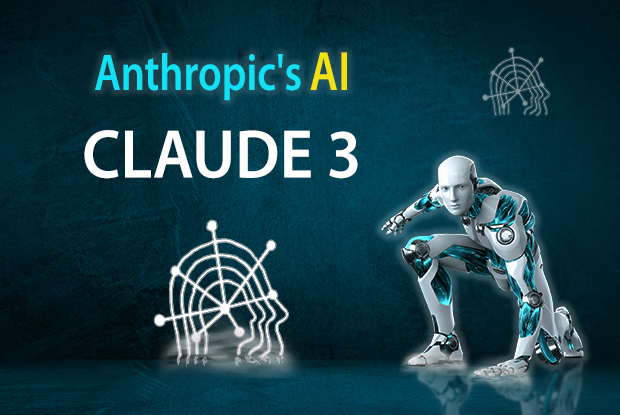Introduction
Numerous intriguing and significant technologies have emerged as a result of artificial intelligence's (AI) quick development. Among these, large language models (LLMs) like OpenAI's GPT-3 have had a profound impact on our comprehension of and interactions with AI. Anthropic, a research group that focuses on long-term structural issues in artificial intelligence, has now unveiled CLAUDE AI, their own LLM.
In this blog, we will explore Claude AI, Its various models, features, Applications, and Limitations.
Who is Antropic AI?
Claude is an AI chatbot created by Anthropic. It is supposed to develop text-based content and engage in discussions in the same way that humans do. The initial edition, powered by LLM Claude 1.3, was launched in March 2023. Claude increased its content width from 9,000 to 100,000 tokens in May.
Just after July, the second version of Claude AI, Claude 2, was released, which was a larger and more powerful LLM than the previous one. Claude 2 can link to large volumes of data, allowing it to foresee patterns, compare and contrast papers, and even perform Q&A. It allows users to submit technical documentation, such as codebases or long literary works. Claude 2 can manage approximately 75,000 words.
Then after some time Claude 3 was launched by Antropic AI, which set a new industry benchmark by processing 200,000 words while significantly reducing hallucinations compared to earlier versions.
LLM (Large Language Models)
Large language models (LLMs) are AI language models with many parameters that can perform a wide range of surprisingly valuable functions. These models are trained on massive volumes of text data and can produce human-like language, answer queries, summarize facts, and so on.
Claude is a conversational assistant built on a Large language model that has been refined and trained with RLHF to be more helpful, honest, and harmless.
Various Models Of Claude AI
Claude AI is a family of cutting-edge LLM (Large language models) created by Anthropic. These models are intended to deliver the greatest possible experience when dealing with AI, giving a variety of features and performance levels to meet specific demands and making it simple to install high-performing, safe, and steerable models.
- Claude 1.2 Instant
- Claude 2.0
- Claude 2.1
- Claude 3
Claude 3 Opus
Claude 3 Haiku
Claude 3 Sonnet
Claude 1.3 & Claude 1.2 Instant
Anthropic AI's first foundation models for natural language processing tasks were Claude 1.3 and Claude 1.2 (Instant). Claude 1.2 Instant is a fast, inexpensive, and highly capable version of Claude AI. Claude 1.2 Instant features a 100K token context window, which means it can operate on hundreds of pages.
Drop many documents, or even a book, into the prompt and ask Claude Instant questions that involve knowledge synthesis from multiple sections of the text. You may also customize Claude Instant for your specific company needs, or instruct it to talk in your brand voice.
Latest API model:- Claude-instant-1.2
Applications
Extract Information:-
Extract information like names, dates, locations, ages, or other factual information from your document and book.
Answering Questions:-
Provide answers to questions based on textual analysis. For example, read a section and respond to questions regarding crucial features in the text with relevant sentences.
Content Generation:-
Create fresh texts based on specific criteria and circumstances. For example, use examples of previous content and brand identity rules to produce a blog post on a certain topic in a casual tone.
Limitations
This model of Claude AI has some limitations too. It can hallucinate details, fill in the gap in knowledge with fabrication, and get facts wrong. It should not be used in high-stakes causes where answers could cause harm.
This model has multilingual capabilities but performs less strongly in low-resource languages.
This model does not use search the web currently but can interact with the document or book shared and can only answer questions using data from before early 2023.
Claude 2.0
Claude 2.0 is simply an updated version of Claude AI that provides better performance, aptitude, reaction, and accessibility via an Application programming interface (API).
It has an impressive 100k token capacity for a context window. This suggests that Claude can handle books or even hundreds of pages of technical documentation.
Latest API model:- Claude-2.0
Applications
Assistance in Programming:-
This Claude AI model is programming capable and can be used to generate code snippets, debug code, and explain complex concepts in order to accelerate application and software development.
Customer Support:-
This model of Claude AI provides improved context-aware responses that are more accurate and human-like.
Language Translation:-
Using this Claude AI model, you can create applications that provide real-time translation by leveraging advanced multilingual capabilities.
Creative Arts:-
This model has creative artistic ability so that it can collaborate with artists to generate content like essays, short stories, lyrics of songs, and other musical compositions.
Education:-
It is ideal for personalized learning. Students can use it to master complex topics more quickly.
Craft Business Plans:-
This version of the Claude AI model from Antropic AI is capable of planning various business functions and can benefit in many ways. It can be used in the following business processes Customer Support, Marketing, Content Creation, Sales, Accounting, and Lead Generation.
Limitations
Apart from various capabilities and features this version of Claude AI model also has some limitations. While it has extensive knowledge from rigorous training but can lack data or facts on new topics or developments after its last training period ended. You can encounter boundaries while enquiring about the latest developments or changes in areas absent from its training materials.
Claude 2.1
Claude 2.1 is just an upgraded version of the Anthropic AI’s Claude AI model. This model improves significantly on its predecessor, Claude 2.0, with an emphasis on widening the context window, lowering hallucination rates, and providing experimental tool use features.
What’s new in Claude 2.1 compared to Claude 2.0?

When it comes to open-ended conversations and document Q&A, Claude 2.1 has 50% fewer hallucinations in misleading claims, 30% fewer inaccurate replies, and a 3–4 times lower rate of incorrectly concluding that a document supports a certain viewpoint than Claude 2.0.
Context Window:- Claude 2.1 supports 200,000 tokens, which is around 150,000 words or more than 500 pages of documentation.
Latest API model:- Claude-2.1
Applications
When you upload a large amount of data to Claude 2.1, you can summarize it, conduct Q&A, forecast trends, and compare and contrast numerous documents to help you develop business plans and analyze complex contracts.
Claude 3
On March 4th, 2024, Anthropic AI revealed its latest Claude AI model, Claude 3, which "sets new industry benchmarks across a wide range of cognitive tasks."
Claude 3 is trained using enormous amounts of text data from public web pages such as Wikipedia articles and books. Anthropics has employed reinforcement learning and human interaction to better predict the next most likely word in its chain of responses.
Claude 3 is a family of three AI models, each with unique performance characteristics that enable users to strike the optimal mix of cost, speed, and intelligence. All models excel in content production, code generation, and multilingual communication.
Claude 3 Opus
Opus, described as "powerful," is the most intelligent of the three models, outperforming Sonnet and Haiku on a variety of AI system evaluation benchmarks. It outperforms competing models such as fundamental mathematics and graduate-level expert reasoning.
It is the most advanced and intelligent model of Claude 3 with human-like intelligence. It delivers state-of-the-art performance on highly complex tasks with demonstration fluency.
Latest API model:- Claude-3-opus-20240229
Claude 3 Sonnet
Sonnet, described as "hard-working," is the model in the middle of the three. It outperforms Opus in terms of cognitive performance and processing speed.
It seeks to create a balance between speed and performance. It is more suited to supporting enterprise functions such as data processing, quality control, and product suggestions.
Latest API model:- Claude-3-sonnet-20240229
Claude 3 Haiku
This is the fastest and most compact type, built for nearly instant responsiveness and smooth AI experiences that resemble human interactions.
Latest API model:- Claude-3-haiku-20240307
Key Features Of Claude 3 AI Models
Model upgrades:-
To improve performance, increase functionality, and fix any found problems, the Claude AI 3 family gets updates from time to time. To ensure that your processes on one model version do not break with the introduction of a new version, every update gets pinned to a new version of the model.
It provides developers time to update their programs after the release of a new model version.
Vision and image processing:-
All Claude 3 models can process and analyze visual input, extract insights from documents, process web UI, generate image catalog metadata, and perform other tasks.
Multilingual capabilities:-
The enhanced fluency of Claude 3 models in non-English languages, like Spanish and Japanese, opens up use cases such as translation services and international content production.
Steerability and usability:-
These Claude AI models are more adept at obeying instructions and are simpler to maneuver. This results in more predictable, higher-quality outputs and provides you with more control over the behavior of the model.
Applications Of Claude 3 AI Models
Data extraction and filtering:-
Haiku's speed may be useful for tasks like real-time extraction of important information from news articles or social media posts.
Text generation and editing:-
Sonnet can be used for a variety of writing tasks, including creating different creative text formats, summarizing information, and editing and improving existing texts.
Code generation and analysis:-
Generating code snippets from instructions in natural language and examining code for possible problems are two tasks for which Sonnet's text and code comprehension skills may be helpful.
Complex reasoning and problem-solving:-
Opus, the most potent variety, was able to handle difficult tasks involving complex reasoning, such as drug discovery simulations or scientific research.
Adaptive and personalized systems:-
Its capacity to learn from small amounts of data (few-shot learning) could enable personalized experiences in recommendation engines, healthcare, and education.
Creative content generation:-
Opus's powers could be applied to produce extremely sophisticated and imaginative content, perhaps even better than what is possible with other models.
Limitations
Early access users report that Claude 3 works effectively for fact-based queries and educational assignments. However, it occasionally has trouble with mathematical and difficult reasoning tasks. Biased replies do occur occasionally.
The Claude 3 is now the priciest model available, although there are talks of more economical plans in the near future.
How To Use Claude AI tool?

To use Claude AI chatbot you just need to follow the steps below:-
First, go to www.claude.ai and sign up for free with your email address. From there, you may start a conversation by selecting one of Claude's basic starters or creating your own.
Enter your prompt and wait for the output. You can also feed Claude your PDFs and URLs, which will summarize the information. Keep in mind that you may only use 50 prompts per day with Claude's free edition.
Claude also offers a Pro version for $20 a month, which includes more prompts every day and early access to new features as they are published. You may access Claude Pro by either upgrading your existing account or creating a new one.
How are Claude AI LLM models compared to other LLM AI models?
Can Process More Words
All Claude AI models can handle between 100k and 200k words at once, whereas other AI tools, such as Gpt4 and Gpt3.5, can only process 64,000 and 25,000 words. This provides Claude a bigger "context window" than its competitors, allowing it to recall and examine more words from earlier in a conversation as well as longer materials (such as research studies or books).
Claude AI does not save user information
Claude AI does not retain its user data and automatically deletes prompts and outputs after a period of 90 days. Anthropic AI is transparent about its data privacy policy that it does not save user conversations with the Claude AI model from training, while its other competitors have cleared that they save conversations for future training of its AI model.
Prioritize Safety More Than Its Competitors
Antropic AI's usage of constitutional AI decreases the chatbot's risk of producing toxic, hazardous, or unethical outputs.
Because of this, Claude AI is an interesting AI tool for higher-stake sectors such as healthcare or law, where organizations cannot afford incorrect or harmful responses. Organizations using Claude AI can have greater confidence in the quality of their work.
Conclusion
Anthropic AI researchers want to improve Generative AI's stability and usefulness. They plan to leverage the potential of Constitutional AI not only to improve responses but also to make them easier for people to understand.
Claude 3 is expected to replicate human answers, just as humans do when they understand the correct responses. This blog gives you a complete idea of Claude AI models, their applications, and many more.
As Anthropic continues to enhance and expand the capabilities of Claude AI, the potential influence on businesses and society grows exponentially. With its multimodal processing, speed improvements, and architectural innovations, Claude AI models have the potential to transform how we engage with and use AI technology.



